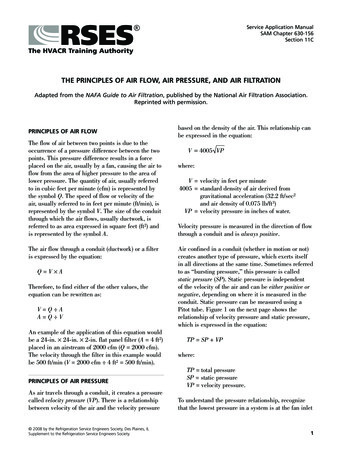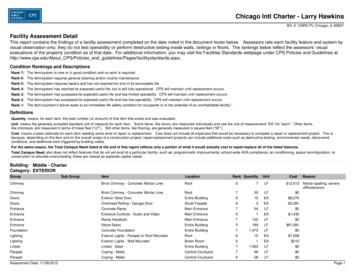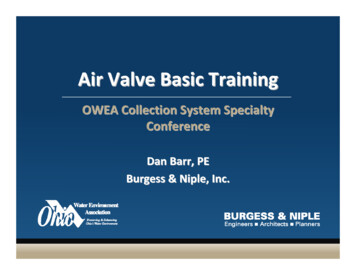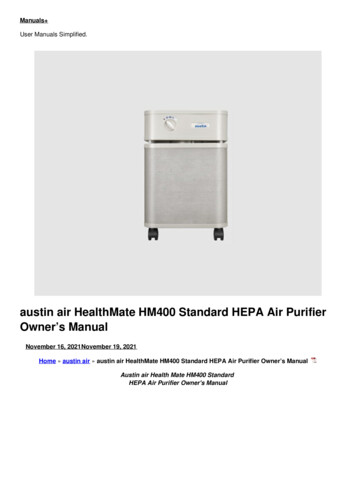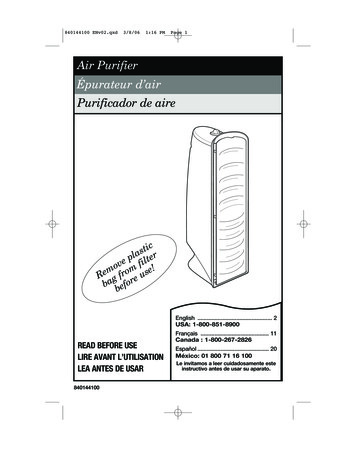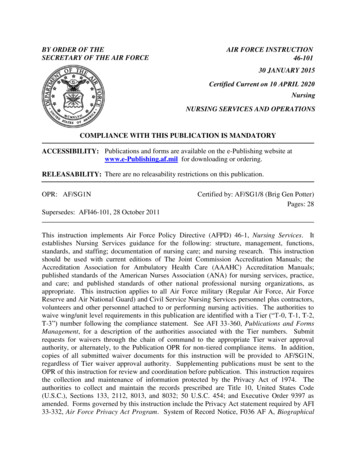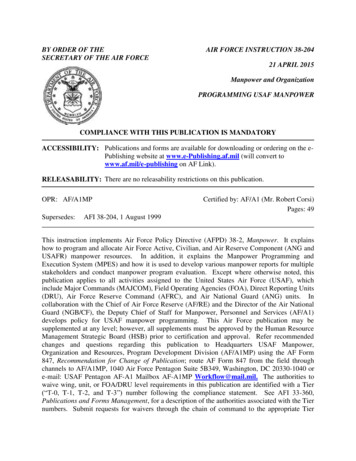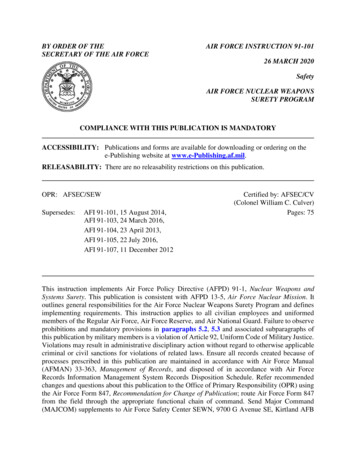
Transcription
BY ORDER OF THESECRETARY OF THE AIR FORCEAIR FORCE INSTRUCTION 91-10126 MARCH 2020SafetyAIR FORCE NUCLEAR WEAPONSSURETY PROGRAMCOMPLIANCE WITH THIS PUBLICATION IS MANDATORYACCESSIBILITY: Publications and forms are available for downloading or ordering on thee-Publishing website at www.e-Publishing.af.mil.RELEASABILITY: There are no releasability restrictions on this publication.OPR: AFSEC/SEWSupersedes:AFI 91-101, 15 August 2014,AFI 91-103, 24 March 2016,AFI 91-104, 23 April 2013,AFI 91-105, 22 July 2016,AFI 91-107, 11 December 2012Certified by: AFSEC/CV(Colonel William C. Culver)Pages: 75This instruction implements Air Force Policy Directive (AFPD) 91-1, Nuclear Weapons andSystems Surety. This publication is consistent with AFPD 13-5, Air Force Nuclear Mission. Itoutlines general responsibilities for the Air Force Nuclear Weapons Surety Program and definesimplementing requirements. This instruction applies to all civilian employees and uniformedmembers of the Regular Air Force, Air Force Reserve, and Air National Guard. Failure to observeprohibitions and mandatory provisions in paragraphs 5.2, 5.3 and associated subparagraphs ofthis publication by military members is a violation of Article 92, Uniform Code of Military Justice.Violations may result in administrative disciplinary action without regard to otherwise applicablecriminal or civil sanctions for violations of related laws. Ensure all records created because ofprocesses prescribed in this publication are maintained in accordance with Air Force Manual(AFMAN) 33-363, Management of Records, and disposed of in accordance with Air ForceRecords Information Management System Records Disposition Schedule. Refer recommendedchanges and questions about this publication to the Office of Primary Responsibility (OPR) usingthe Air Force Form 847, Recommendation for Change of Publication; route Air Force Form 847from the field through the appropriate functional chain of command. Send Major Command(MAJCOM) supplements to Air Force Safety Center SEWN, 9700 G Avenue SE, Kirtland AFB
2AFI91-101 26 MARCH 2020NM 87117-5670, for coordination before publication. The authorities to waive wing/unit levelrequirements in this publication are identified with a Tier (“T-0, T-1, T-2, T-3”) number followingthe compliance statement. See Air Force Instruction (AFI) 33-360, Publications and FormsManagement, Table 1.1 for a description of the authorities associated with the Tier numbers.Submit requests for waivers through the chain of command to the appropriate Tier waiver approvalauthority, or alternately, to the requestor’s commander for non-tiered compliance items.SUMMARY OF CHANGESThis document has been substantially revised and must be completely reviewed. This instructionconsolidated and revised four AFIs and parts of a fifth as stated in the Supersedes section. Relevantresponsibilities have been consolidated into Chapter 2 of this document from the aforementionedAFIs. Chapter 3 contains directives and procedures to establish various installation level nuclearsurety programs. Significant changes to the Special Nuclear Surety Policy and Deviation Process inChapter 8 have been made. Note: The list of items that do not require nuclear safety designcertification, formally in AFI 91-103, have been placed in AFMAN 91-118, Safety Design andEvaluation Criteria for Nuclear Weapons Systems, and AFMAN 91-119, Safety Design andEvaluation Criteria for Nuclear Weapon Systems Software. Also, the remainder of AFI 91-107 notmerged with this document (including numerical requirements) has been placed in AFMAN91-118. Note: AFI 91-101 is the parent document of the following publications: AFI 91-106, AFI91-108, AFI 91-111, AFI 91-112, AFI 91-114, AFI 91-115, AFI 91-116, AFI 91-117, AFMAN91-118, and AFMAN 91-119. As such, the terms and definitions found in this publication apply toall aforementioned documents for the purpose of nuclear safety design.Chapter 1—INTRODUCTION71.1.Purpose.71.2.Nuclear Weapons Surety Standards. .71.3.Nuclear Surety Procedures. .71.4.Commanders and Directors. .81.5.Risk Assessment and Management. .8Table 1.1.Nuclear Extended Risk Matrix.9Chapter 2—ROLES AND RESPONSIBILITIES102.1.Assistant Secretary of the Air Force for Acquisition shall: .102.2.Air Force Chief of Safety (AF/SE) will establish and oversee the Air ForceNuclear Weapons Surety Program and shall: .102.3.Deputy Chief of Staff, Operations, Plans and Requirements shall: .122.4.Deputy Chief of Staff, Strategic Deterrence & Nuclear Integration shall: .132.5.Deputy Chief of Staff/Logistics, Installations & Mission Support shall: .13
AFI91-101 26 MARCH 202032.6.The Nuclear Weapon System Surety Group: .132.7.Program Executive Officers shall: .142.8.Program Managers: .142.9.MAJCOMs, Field Operating Agencies, and Direct Reporting Units Commanders,as appropriate: .152.10.MAJCOM Nuclear Surety Deviation Reporting Program OPR shall:.172.11.Air Force Materiel Command Commander. .172.12.Air Force Global Strike Command Commander. .192.13.US Air Forces in Europe Commander. .192.14.Air Education and Training Command Commander. .202.15.Headquarters Air Force/Center Requirement Owners and MAJCOM StaffAgencies shall: .202.16.MAJCOM Weapons Safety Office shall: .202.17.Numbered Air Force Weapons Safety Managers shall: .212.18.Joint Basing: .212.19.Commanders of Organizations Possessing Critical Components shall: .212.20.Wing/Installation Commanders shall:.222.21.Air Force Reserve and Air National Guard Commanders will: .222.22.Wing/Base Level Weapon Safety Managers: .222.23.Maintenance Squadron Commander. .242.24.Force Support Squadron Commander. .242.25.Medical Treatment Facility Commander. .242.26.Civil Engineer Commander. .242.27.Security Forces Commander. .252.28.Unit/Squadron Commanders shall: .252.29.Unit Safety Representatives shall: .262.30.Wing Commanders Without a Nuclear Mission shall: .262.31.Supervisors shall: .262.32.Individuals shall: .26
4AFI91-101 26 MARCH 2020Chapter 3—AIR FORCE INSTALLATION LEVEL NUCLEAR SURETY PROGRAM283.1.Purpose. .283.2.General Duties. .283.3.Host Tenant Agreements.283.4.Nuclear Surety Council. .293.5.Facility Programs. .293.6.Training Programs. .303.7.Tamper Control and Detection Programs. .323.8.Independence Programs. .333.9.No-Lone Zone Programs. .33Chapter 4—AIR FORCE NUCLEAR SAFETY DESIGN CERTIFICATION PROGRAM344.1.Overview. .344.2.Items That Require Nuclear Safety Design Certification. .344.3.Items That Do Not Require Nuclear Safety Design Certification.354.4.Nuclear Safety Design Certification Process for Materiel. .354.5.Critical Components. .374.6.Tamper Detection Indicators.374.7.Special Test and Maintenance Programs. .384.8.Technical Orders that Include Nuclear Surety Procedures Certification Process: .384.9.Additional Requirements. .384.10.Warhead and Bomb Maintenance or Test Procedures. .384.11.Facility Lifting and Suspension Systems. .394.12.Nuclear Safety Design Decertification. .404.13.Operational Decertification. .40Chapter 5—NUCLEAR SURETY TAMPER CONTROL AND DETECTION PROGRAMS415.1.Tamper Control Program. .415.2.Two-Person Concept Requirements. .415.3.Two-Person Concept Violations and Reporting. .415.4.Authorized Deviations. .42
AFI91-101 26 MARCH 202055.5.Additional Conditions: .435.6.Sealing Methods. .44Chapter 6—CRITICAL COMPONENTS456.1.Designating Critical Components. .456.2.Marking Critical Components. .456.3.Two-Person Concept. .456.4.Shipping Requirements. .456.5.Storage Requirements and Operational Use of Critical Components. .456.6.Targeting. .46Chapter 7—TROUBLESHOOTING AND MAINTENANCE OPERATIONS477.1.Introduction. .477.2.Faults. .477.3.Allowable Operations. .477.4.Inadequate Operations. .477.5.Field-level Maintenance Personnel. .477.6.Prohibited Operations Request. .477.7.Criteria Unique to Aircraft Systems. .477.8.Criteria Unique to Ground-Launched Missile Systems. .507.9.Internal Weapons Components. .51Chapter 8—NUCLEAR SURETY DEVIATION PROCESS528.1.General. .528.2.Deviation Reporting. .528.3.Nuclear Surety Deviation Categories.538.4.Nuclear Surety Deviation Package. .538.5.Submission Process for Nuclear Surety Operational Deviations. .54Figure 8.1.Nuclear Surety Operation Deviation Process.558.6.Deviations to Nuclear Safety Design and Evaluation. .55Figure 8.2.Nuclear Surety Safety Design Deviation Process. .568.7.Cancellation Process. .56
6AFI91-101 26 MARCH 20208.8.Annual Report. .56Attachment 1—GLOSSARY OF REFERENCES AND SUPPORTING INFORMATION58Attachment 2—RECOMMENDED OUTLINE FOR THE NUCLEAR SURETYEVALUATION75
AFI91-101 26 MARCH 20207Chapter 1INTRODUCTION1.1. Purpose.1.1.1. The purpose of the Air Force Nuclear Weapons Surety Program is to incorporatemaximum nuclear weapons surety, consistent with operational requirements, from weaponsystem development to target or dismantlement. This instruction implements positive measuresto prevent unauthorized activation of critical functions, including unapproved or inadvertentauthorization, prearming, launching, releasing, arming, and targeting, and protect againstinherent risks and threats, and to ensure components are compatible with the assembled nuclearweapon system.1.1.2. This document serves as the parent document to the following 91-1XX publications:AFI 91-106, Unauthorized Launch, Threat Mitigation, and Launch Action Studies, AFI 91108, Air Force Nuclear Weapons Intrinsic Radiation and 91(B) Radioactive Material SafetyProgram, AFI 91-111, Safety Rules for US Strategic Bomber Aircraft, AFI 91-112, SafetyRules for US/NATO Strike Fighters, AFI 91-114, Safety Rules for the Intercontinental BallisticMissile System, AFI 91-115, Safety Rules for Nuclear Logistics Transport by the PrimeNuclear Airlift Force, AFI 91-116, Safety Rules for Long-Term Storage and MaintenanceOperations for Nuclear Weapons, AFI 91-117, Safety Rules for the Airborne Launch ControlSystem, AFMAN 91-118, and AFMAN 91-119.1.2. Nuclear Weapons Surety Standards. The Air Force Nuclear Weapons Surety Programensures personnel that design and operate nuclear weapons and nuclear weapon systems satisfythe surety standards in Department of Defense (DoD) Directive 3150.02, DoD Nuclear WeaponsSurety Program. The four DoD nuclear weapons surety standards are:1.2.1. There shall be positive measures to prevent nuclear weapons involved in accidents orincidents, or jettisoned weapons, from producing a nuclear yield. Note: A significant nuclearyield is considered the equivalent of four pounds of TNT as constrained by the Department ofEnergy’s (DOE) one-point safety design criteria in accordance with Department of EnergyOrder 452.1E, Nuclear Explosive and Weapons Safety Program.1.2.2. There shall be positive measures to prevent deliberate prearming, arming, launching, orreleasing of nuclear weapons, except upon execution of emergency war orders or whendirected by competent authority.1.2.3. There shall be positive measures to prevent inadvertent prearming, arming, launching,or releasing of nuclear weapons in all normal and credible abnormal environments.1.2.4. There shall be positive measures to ensure adequate security of nuclear weapons, asgoverned by DoD Directive 5210.41, Security Policy for Protecting Nuclear Weapons.1.3. Nuclear Surety Procedures. A goal of nuclear safety design certification is to maximizeweapon safety within the design to minimize steps called out as nuclear surety procedures withintechnical orders/checklists. Nuclear surety procedures must be performed exactly as written. TheAir Force Safety Center, Weapon Safety Division (AFSEC/SEW) is the adjudicating authority fordetermining which procedures qualify as nuclear surety procedures, but may delegate thatauthority to another competent engineering authority within the United States government.
8AFI91-101 26 MARCH 20201.4. Commanders and Directors. Commanders and Directors at all levels are responsible forthe success of the Air Force Nuclear Weapons Surety Program. Commanders must emphasize thatsafety, security, control, and effectiveness of nuclear weapons are of great importance to the UnitedStates.1.5. Risk Assessment and Management.1.5.1. This publication does not address risk assessment and management for nuclear weaponsystem environmental, safety, occupational, and health risks that cannot result in a nuclearyield or dispersal of nuclear materials and that neither impact nuclear weapons directly noraffect the manner in which the weapon system complies with any of the nuclear weapons suretystandards. For guidance on assessing and managing these non-nuclear environmental, safety,occupational, and health risks consult AFI 90-802, Risk Management, Military Standard 882E,System Safety, DoD Instruction 5000.02, Operation of the Defense Acquisition System, andAFI 63-101/20-101, Integrated Life Cycle Management.1.5.2. Risk management for nuclear consequences is handled with the same general approachor methodology to that described in AFI 90-802 and Military Standard 882E, tailored for thenuclear application. Risk is categorized using a combination of frequency, quantified as asystem’s lifetime probability of an adverse nuclear event occurring and ranging from one inten to one in one trillion; and severity, rated on an increasing scale ranging from localizedplutonium dispersal through to full-scale nuclear detonation. The aggregate risk level isdetermined by calculating the frequency and severity of potential consequences resulting froma mishap and finding the risk element in Table 1.1 at the intersection of the assessed frequencyand severity.1.5.3. Due to the nature of nuclear weapons, the conventional low, medium, serious, and highrisk categories are insufficient to address the potential outcomes. As a result, very high,extreme, and existential categories were added and assigned such that they were consistentwith the probabilities normally included in nuclear weapon Military Characteristics asdescribed in DoD Manual 3150.02, DoD Nuclear Weapon System Safety Program Manual,paragraph 2b.1.5.4. Nuclear-scale consequences include but are not limited to damage to a nuclear weapon,dispersal of nuclear materials, and generation of nuclear yield.1.5.5. Safety design criteria described in this document, AFMAN 91-118, and AFMAN 91119 are intended to reduce the probability of the occurrence of an event with nuclear-scaleconsequences such that the aggregate risk is reduced to no greater than a high categorization.Full compliance with all safety design criteria or use of approved procedures is consideredadequate rigor for ensuring compliance with safety requirements of DoD Directive 3150.02and therefore does not require additional risk management measures. Non-compliance withany safety design requirements resulting in the application of alternative measures for reducingrisk, requires a rigorous probabilistic risk assessment of the system under the alternativemeasures to show that the aggregate risk does not exceed a high categorization. Approval ofnew procedures may require a probabilistic risk assessment if the procedures involveoperations that defeat weapon safety features or create the potential for exposing a nuclearweapon to an abnormal environment. Note: DOE-STD-1628-2013, Development ofProbabilistic Risk Assessments for Nuclear Safety Applications, provides guidance onperforming probabilistic risk assessments as well as references to industry standards regarding
AFI91-101 26 MARCH 20209probabilistic risk assessment. Note: Numerical requirements for inadvertent critical functionactivation are located in AFMAN 91-118.1.5.6. Risk acceptance authorities. Using the Nuclear Extended Risk Matrix in Table 1.1, therisk acceptance authority is found by determining the consequence, ordered by severity alongthe horizontal axis, and the probability of a given failure mode, ordered by the probability ofoccurrence along the vertical axis. The intersection of these two parameters in Table 1.1provides the risk level. The risk acceptance authority for the determined risk level is as follows:1.5.6.1. Risk acceptance for risk levels falling in the low, medium, serious, and highcategories is managed through the MAJCOM with the same risk acceptance authority asthese risk categories for conventional risks. Consult AFI 90-802 and MIL-STD-882E forguidance on risk acceptance for risk categorized as high and below.1.5.6.2. Risk acceptance for risk levels falling in the very high, extreme, and existentialcategories is managed through the Nuclear Weapons Systems Surety Group forcoordination through the Office of the Secretary of Defense, Undersecretary forAcquisition and Sustainment (USD A&S) to identify and obtain concurrence of the properrisk acceptance authority.Table 1.1. Nuclear Extended Risk Matrix.
10AFI91-101 26 MARCH 2020Chapter 2ROLES AND RESPONSIBILITIES2.1. Assistant Secretary of the Air Force for Acquisition shall:2.1.1. Assign a Program Manager for nuclear certified items. (T-0).2.1.2. Ensure any shortfall in meeting nuclear design requirements be corrected by theProgram Executive Officer, granted a deviation based on a probabilistic risk assessment andaccompanying risk acceptance, or granted a deviation with compensatory measures by theapproval authority for the organization establishing the design requirement. Operational riskacceptance is owned by the lead MAJCOM, the Program Executive Officer does not ownoperational risk acceptance.2.2. Air Force Chief of Safety (AF/SE) will establish and oversee the Air Force NuclearWeapons Surety Program and shall:2.2.1. Establish nuclear weapons surety program requirements.2.2.2. Publish instructions and guidance on the various portions of the program as required.2.2.3. Maintain liaison for nuclear weapons surety matters with organizations outside the AirForce.2.2.4. Advise the Office of the Secretary of the Air Force and the Assistant Secretary of theAir Force (Acquisition) on required nuclear surety policies associated with new technologies.2.2.5. Provide, at the request of commanders, integrated surety visits to assist in developing arobust nuclear weapons surety program.2.2.6. Ensure deviations are reviewed by technical authorities and briefed during Air ForceNuclear Surety Council and Nuclear Weapon System Surety Group meetings in accordancewith AFI 91-102, Nuclear Weapon System Safety Studies, Operational Safety Reviews, andSafety Rules.2.2.7. Maintain the Air Force authoritative tracking catalog for all deviations.2.2.8. Ensure Air Force Chief of Safety and Deputy Chief of Staff for Logistics, Engineering,and Force Protection, Headquarters Air Force require formal MAJCOM commandercoordination on Draft Annual Nuclear Surety Deviation Report no later than 15 February.(T-1).2.2.9. Establish the minimum content of the Nuclear Surety Training Program. Create anddistribute standardized nuclear weapons surety lesson plans and testing materials to MAJCOMWeapons Safety Offices. Coordinate lesson plans through Air Education and TrainingCommand prior to distribution to MAJCOMs.2.2.10. Distribute new nuclear weapons surety testing materials to MAJCOMs within twomonths after being notified of compromise of test material.2.2.11. Oversee the Air Force Nuclear Surety Tamper Control and Detection Programs.2.2.12. Establish requirements to designate, certify, and manage the critical componentprocess. (T-0).
AFI91-101 26 MARCH 2020112.2.13. Through AFSEC/SEW, AF/SE shall:2.2.13.1. Approve new or major changes to Operation Certification/OperationalDecertification (OPCERT/DECERT) procedures and procedural controls for criticalcomponents. These procedures must adequately verify the system or component functionsas design certified and mitigate all credible threats and scenarios. Note: The abbreviatedterms OPCERT and DECERT are uniquely distinct from the Operational Certification andOperational Decertification terms without this abbreviation.2.2.13.2. Establish criteria for nuclear surety procedures to be identified by the ProgramManager.2.2.13.3. Approve identified nuclear surety procedure tasks.2.2.13.4. Provide augmentation to Air Force Inspection Agency nuclear surety inspectionoversight teams in support of the Inspector General of the Air Force oversightresponsibilities.2.2.13.5. Provide assistance or augmentation to the MAJCOM safety office on request forinspections, staff assistance efforts, or special interest evaluations relating to nuclearweapons surety at any level within the requesting command.2.2.13.6. Certify the design of sealing methods proposed for use in nuclear weaponsystems in accordance with Chapter 4 of this instruction.2.2.13.7. Designate and certify critical components in accordance with Chapter 6 of thisinstruction (when not designated by the Air Force Nuclear Weapon System Surety Group).2.2.13.8. Designate split-handling or split-knowledge procedures for critical componentsif not previously determined or if procedures proposed or in use are determined byAFSEC/SEW to be inadequate (when not designated by the Air Force Nuclear WeaponSystem Surety Group).2.2.13.9. Approve vaults and containers used to store critical components.2.2.13.10. Certify the design of tamper detection indicators in accordance with Chapter 4of this instruction and approve their use to protect the certification status of criticalcomponents.2.2.13.11. Develop and publish Air Force safety design and evaluation criteria.2.2.13.12. Determine when independent nuclear surety evaluations are required to supportnuclear safety design certification in accordance with Chapter 4 of this instruction, AFI91-102, and AFI 63-125, Nuclear Certification Program.2.2.13.13. Request Air Force Nuclear Weapons Center (AFNWC) support as needed,describing the specific review, evaluation, or analysis required.2.2.13.14. Provide the independent evaluator (typically AFNWC) supporting informationas required to evaluate design compliance with safety design criteria. This supportinginformation is usually provided in the form of a nuclear surety evaluation delivered by theProgram Manager.2.2.13.15. Review nuclear surety evaluations for compliance with all nuclear safety designcertification requirements.
12AFI91-101 26 MARCH 20202.2.13.16. Identify, if required, the suspense time/date for safety design certificationactions (normally identified in the Certification Requirements Plan developed inaccordance with AFI 63-125).2.2.13.17. Establish the Air Force Nuclear Surety Deviation Reporting Program.2.2.13.18. Review/coordinate as appropriate and evaluate deviation requests, i.e., AFForm 116, Request for Deviation from Security Criteria, in accordance with Chapter 8 ofthis instruction.2.2.13.19. Review and coordinate on Nuclear Certification Impact Statements submittedby the program office(s).2.2.13.20. Approve the nuclear safety certification annex(es) to the CertificationRequirements Plan to ensure nuclear safety design certification requirements areadequately addressed.2.2.13.21. Approve new or revised test and weapon maintenance procedures for nuclearweapons performed in Air Force facilities, as well as approve the performance of currentprocedures not currently approved for a given facility.2.2.13.22. Conduct nuclear safety design certification of hardware, software, procedures,and facilities to be used with nuclear weapons.2.2.13.23. Issue a nuclear safety design certification letter to the AFNWC upon completionof all nuclear safety design certification actions identified in the Certification RequirementsPlan.2.2.13.24. Identify
COMPLIANCE WITH THIS PUBLICATION IS MANDATORY ACCESSIBILITY: Publications and forms are available for downloading or ordering on the e-Publishing website at . www.e-Publishing.af.mil. RELEASABILITY: There are no releasability restrictions on this publication. OPR: AFSEC/SEW Supersedes: AFI 91-101, 15 August 2014, AFI 91-103, 24 March 2016,





